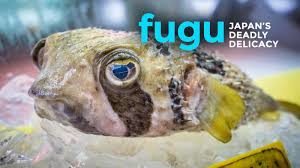 Most folks think great white, tiger and mako sharks are the world’s most deadly fish. They’re dangerous, all right, but the deep’s deadliest distinction goes to the cute little pufferfish you remember from Disney’s Little Mermaid. Also called blowfish and sunfish, these sashimi delicacies known as fugu kill 10 times more people per year than sharks. And they do it a lot slower and far more viciously.
Most folks think great white, tiger and mako sharks are the world’s most deadly fish. They’re dangerous, all right, but the deep’s deadliest distinction goes to the cute little pufferfish you remember from Disney’s Little Mermaid. Also called blowfish and sunfish, these sashimi delicacies known as fugu kill 10 times more people per year than sharks. And they do it a lot slower and far more viciously.
Shark attack deaths are super rare. Sharks kill an average of 5 people each year worldwide, although statistics show at least 80 violent human to shark encounters happen annually. Most shark victims are seriously injured like having an arm or leg torn apart, yet somehow survive. Not so with pufferfish poisoning.
Pufferfish death statistics are hard to nail down, but the World Health Organization and an article in National Geographic confirm at least 50 people expire every year after ingesting neurotoxins found in pufferfish livers, ovaries, testicles, intestines and skin. Hundreds more become seriously ill and only bounce back through immediate medical intervention.
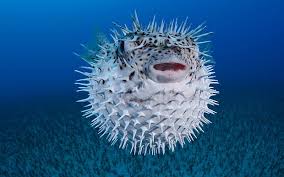 What makes pufferfish so toxic is tetrodotoxin. It’s 1,200 times more powerful than potassium cyanide which the Nazis used in their poison pills. Tetrodotoxin is the world’s deadliest substance by volume next to anthrax and a chemical inside the tropical cone snail. In fact, tetrodotoxin is far more lethal than venom found in the common death adder and the notorious taipan snake. Injecting 1 microdot of pure tetrodotoxin will kill the average-sized human. That’s equivalent to 10 nanograms, which is an amount impossible to see with the naked eye.
What makes pufferfish so toxic is tetrodotoxin. It’s 1,200 times more powerful than potassium cyanide which the Nazis used in their poison pills. Tetrodotoxin is the world’s deadliest substance by volume next to anthrax and a chemical inside the tropical cone snail. In fact, tetrodotoxin is far more lethal than venom found in the common death adder and the notorious taipan snake. Injecting 1 microdot of pure tetrodotoxin will kill the average-sized human. That’s equivalent to 10 nanograms, which is an amount impossible to see with the naked eye.
So why are powerfully poisonous pufferfish such a preferred palatable pleasure?
It’s because specialized fugu chefs know how to safely filet this culinary delight. In Japan, where fugu is so popular, chefs undergo a state-required licensing program. Apprentice fugu chefs train for 3 years before taking a written, oral and practical exam on the 30 prescribed steps for properly preparing pufferfish. Only a third pass.
Fugu chefs are extremely cautious about processing their pufferfish. They meticulously remove the toxic parts and treat the offal like nuclear waste. Pufferfish flesh is delicate and exceptionally tasty. The Japanese have a high demand for this sashimi dish, but it’s popular all through the warm water world where pufferfish naturally occur.
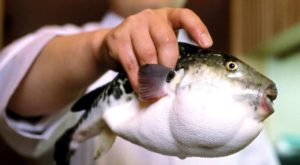 There are over 120 different pufferfish or tetrodontiforme sub-species. An adult dwarf blowfish is only an inch long and too small for a meal. But the largest fugu fish reach two feet in length and weigh up to five pounds. Pufferfish get their common name from a defensive ability to swallow water and expand their stomachs up to four times. Blowing into a ball shape makes pufferfish hard to grip by predators’ teeth. Many sub-species have sharp, poisonous spikes on the skin surface which lay flat when uninflated. However, when alarmed and expanded, pufferfish turn into deadly mines.
There are over 120 different pufferfish or tetrodontiforme sub-species. An adult dwarf blowfish is only an inch long and too small for a meal. But the largest fugu fish reach two feet in length and weigh up to five pounds. Pufferfish get their common name from a defensive ability to swallow water and expand their stomachs up to four times. Blowing into a ball shape makes pufferfish hard to grip by predators’ teeth. Many sub-species have sharp, poisonous spikes on the skin surface which lay flat when uninflated. However, when alarmed and expanded, pufferfish turn into deadly mines.
Pufferfish don’t manufacture tetrodotoxin within a body system.
Rather, tetrodotoxin is a byproduct made by invasive bacteria that pufferfish ingest in their food. Snails are the main part of pufferfish diet. These subtle sea creatures contain a combination of alteromona, shewanella and vibrio bacteria which react with pufferfish innards to isolate tetrodotoxin. Evolution created a pufferfish immunity to the toxin where sodium channels are mutated. This is why the bacterial doesn’t kill its host.
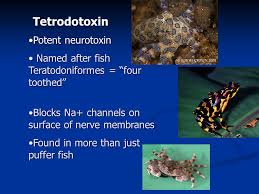 But tetrodotoxin certainly tries to kill anything trying to eat a pufferfish, particularly human beings. It does this by molecularly bonding to cells and blocking the sodium channels which allow neurological information instructing cells to be elastic. When sodium channels are blocked, cells remain neutral or paralyzed. If enough tetrodotoxin is taken, the victim suffers total paralysis including the diaphragm’s ability to move. There’s no lung inhaling or exhaling and the stricken person smothers while remaining totally conscious.
But tetrodotoxin certainly tries to kill anything trying to eat a pufferfish, particularly human beings. It does this by molecularly bonding to cells and blocking the sodium channels which allow neurological information instructing cells to be elastic. When sodium channels are blocked, cells remain neutral or paralyzed. If enough tetrodotoxin is taken, the victim suffers total paralysis including the diaphragm’s ability to move. There’s no lung inhaling or exhaling and the stricken person smothers while remaining totally conscious.
It’s a nasty way to die—lying there with eyes open and knowing the end is near. But not all pufferfish poisoning patients die. It greatly depends on the amount or dose of tetrodotoxin consumed. It also depends on having medical assistance present. Standard treatment for tetrodotoxin cases is keeping the ailing victim on mechanical ventilation while the person metabolizes the toxin and excretes it. This can be several days or even weeks if a person becomes comatose. There’s no known antedote.
Even the slightest amount of tetrodotoxin will cause discomfort and distress.
First, the lips and face feel tingly. Similarly, the finger and toes tips are affected. Headache, nausea and vomiting follow. Then total muscular paralysis occurs along with the inability to breathe. Respiratory failure causes a loss of oxygenated blood to the heart and the patient suffers cardiac arrest.
Tetrodotoxin is non-soluble in water and heat resistant. A chef can’t flush tetrodotoxin from pufferfish sashimi flesh. Nor can they cook it out. But tetrodotoxin never occurs naturally in pufferfish flesh. It’s only introduced when an organ is punctured. Once the flesh is contaminated by a leaky liver, gut, bladder, or reproductive organ, it’s impossible to rid. It’s also impossible for the untrained eye to spot a leak as the toxin is colorless.
Despite pufferfish being so dangerous, there’s no hesitation to eat the stuff.
Japan is the largest fugu-consuming country. It’s an important part of their culinary culture. Fugu is a seasonal commodity as the fish’s toxicity is directly related to water temperature. Even though pufferfish require warm, sub-tropical water, tetrodotoxin intensity stays relatively low during the fall and winter when waters are cooler. Once the spring and summer heat hits, the bacteria blooms and pufferfish become far too toxic to risk handling. Even pufferfish urine absorbed through the skin can be lethal.
 The finest fugu pufferfish come from the Shimonoseki region in southern Japan. It’s a city of 250,000 and boasts 500 licensed fugu chefs. Shimonoseki’s fish market is a Mecca for fugu aficionados. It’s world renown in fugu circles, having a giant brass pufferfish statue outside. Live and processed pufferfish are shipped worldwide every day from Shimonoseki and command the industry’s highest price.
The finest fugu pufferfish come from the Shimonoseki region in southern Japan. It’s a city of 250,000 and boasts 500 licensed fugu chefs. Shimonoseki’s fish market is a Mecca for fugu aficionados. It’s world renown in fugu circles, having a giant brass pufferfish statue outside. Live and processed pufferfish are shipped worldwide every day from Shimonoseki and command the industry’s highest price.
The fugu fishing industry is tightly regulated with a restriction on licenses. Fishing openings are on a lottery base and apply daily. Shimonoseki’s fugu market processes over 300 tons of pufferfish yearly. Every day, the market hosts a pufferfish auction where buyers secretly bid with the auctioneer by hand signals concealed in a black cloth bag. This way, no one knows the current price except the successful bidder and auctioneer. This allows fluctuating market prices which is considered healthy for the fugu industry.
Fugu dining isn’t just a palatial experience.
The Japanese have fugu down to an art form. Not only are fugu chefs trained not to poison customers, they’re skilled at delighting guests who will pay $200-300 USD for a fugu dinner. Most fugu is sliced as ultra-thin shimini wafers and accompanied with sushi rice rolls and sauces. This is expected, but the presentation can be breathtaking.
 Top fugu chefs take enormous pride and enjoy tremendous recognition for preparing and presenting their pufferfish. Commonly, fugu platters are laid out in traditional Japanese patterns representing swans and chrysanthemums. They’re a thing of beauty and so is how a fugu dinner unfolds.
Top fugu chefs take enormous pride and enjoy tremendous recognition for preparing and presenting their pufferfish. Commonly, fugu platters are laid out in traditional Japanese patterns representing swans and chrysanthemums. They’re a thing of beauty and so is how a fugu dinner unfolds.
Most fugu dinners run from five to seven courses eaten over several hours. The best fugu restaurants have live tanks where guests pick their personal pufferfish. It’s then prepared in front of the table with the fugu-master fileting the fish and plucking the poison. Guests are progressively served raw or shimini-style fugu followed by cooked fugu in soups, stews and hot saki.
But for every honorable and noble fugu establishment, there are always those pushing the rules.
Believe it or not, there’s a flourishing fugu black market where patrons seek seedy sushi saloons. Some fugu daredevils thrive on devouring fugu tainted with tetrodotoxin. They claim it gives them an incredible high found nowhere else. And where there’s a buck to be made, someone will take it.
Finally, there’s a fugu subculture with its own rules and regulations. For instance, it’s considered bad manners to ask someone else to first try a fugu serving in fine restaurants. It’s also considered crude to take a fugu bite, then mockingly grasp the throat and recoil in agony. And no patron should ever appear shocked when presented their fugu bill.

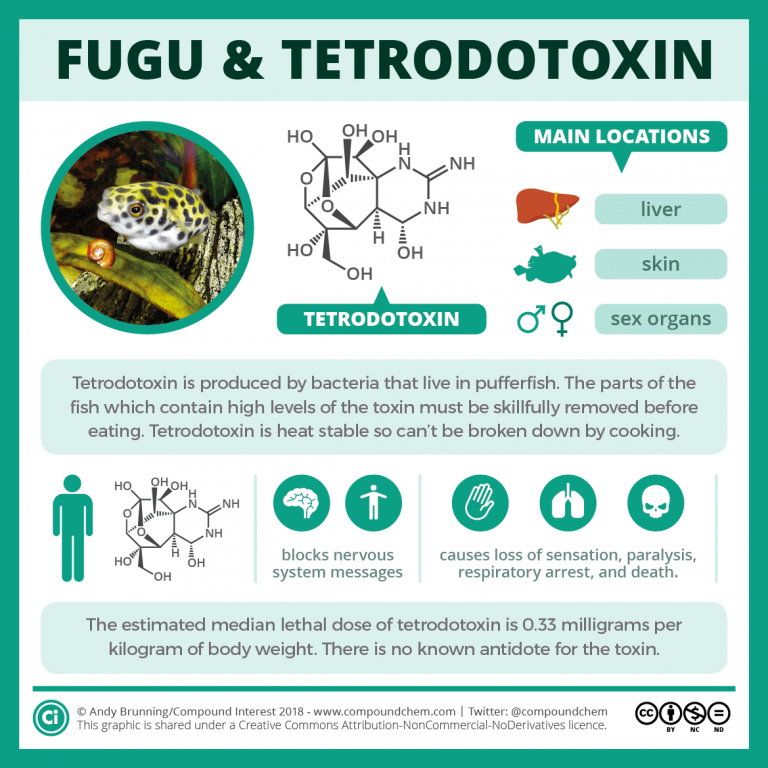
Oh great, now I’m hungry AND want to try and want the challenge of cooking one myself. Thanks, Gary. Stop writing such good stuff. It’s killing me.
Try the liver as an appie, Joe. I hear they’re to die for 🙂
My tapeworm and I will stick with the salmon, thank you.
We used to have Figure Eight Puffers in our aquarium – great little pet (personable and intelligent); I hand fed them. I knew their livers are poisonous, but had no idea that their excretions could bec toxic as well [could explain some of the fish deaths 😉 ]. When trimming their beaks, I held them bare-handed o_O. If we ever decide to stock a tank again – puffers are on the list, along with rubber gloves!
So happy to see you back Garry – you’ve been missed.
Hey there, Sandy. From what I read, different puffer sub-species are more/less toxic than others. Apparently, they’re most toxic in the hot months when it’s mating season. I didn’t know you could get them for personal aquariums – but I don’t know much about pet fish. We have a small pond in the sunroom and have managed to successfully kill off every Koi so far 🙂
Wow. For the right psychopath, a patient killer, this could make a deliciously evil murder weapon. Thanks for the great info., Garry! Nice to see you back in blog-land.
You and I are on the same wavelength. Must be a Libra thing. 😉 Bob and I have been binge-watching David Attenborough documentaries and the information on nature, wildlife, and our planet is so fascinating I was planning to write a post about it. When I do, I’ll link to this post.
I thought you’d find an evil end to this, Sue. I was thinking the same thing – what an excellent plot this could become. Problem is – they can be as dangerous for the perp as the victim. I once caught a pufferfish off the Pacific coast, here. I’d never seen one before but my buddy said, “Don’t bring that f’n thing in the boat! Cut your line! Those things are deadly poisonous!” It was fully puffed, about a foot in diameter and full of spines. You’re right, there are amazing creatures in nature and Planet Earth is an excellent series.
Wow! Great information and it makes you really think… Thanks Garry 🙂
Nice to hear you enjoyed it, Jen. There’s quite the market in America for fugu from what I’ve read. But I think I’ll pass and stay with tuna 🙂
Glad to hear from you, Garry!
Hi Valerie! I’ve been off the blog grid for a few months. Now that I have a commercial writing job wrapped up, I’ll be back to regular posts. Probably one every two weeks. I also have 2-3 new books coming out in 2018. Thanks for following!
I was thinking about you recently and wondering why I haven’t seen a post in a while. Glad to see you are still writing amazing stories that are thoroughly researched .
P.S. I think I ‘ll be off fish for a while after reading this. 😳
Hi Diana – As the Aussies say, “I been flat out like a lizard drinkin” over the past few months doing deadline commercial web content writing for other sites. I saw a news article about a recent fugu scare in Japan where unregulated fugu processed packs got released and it created a public emergency. So I took a look at this stuff. Part of research – I dropped into that new sushi shop on Victoria Cresent and asked if they served fugu. The lady looked at me as if I was crazy and said, “No way – You can kill someone with that stuff.” 🙂